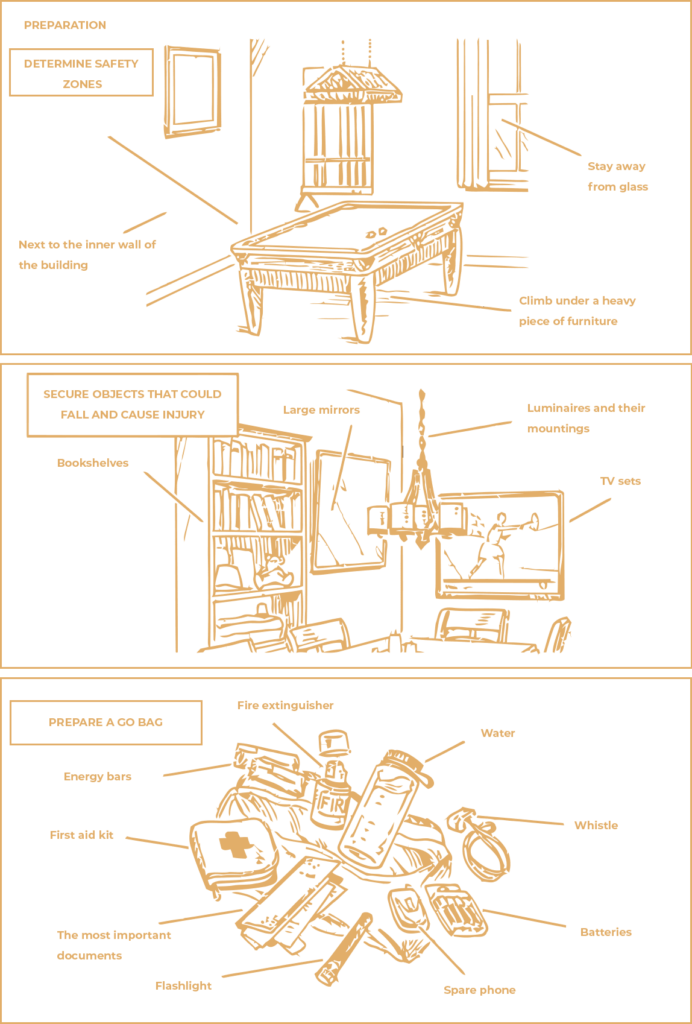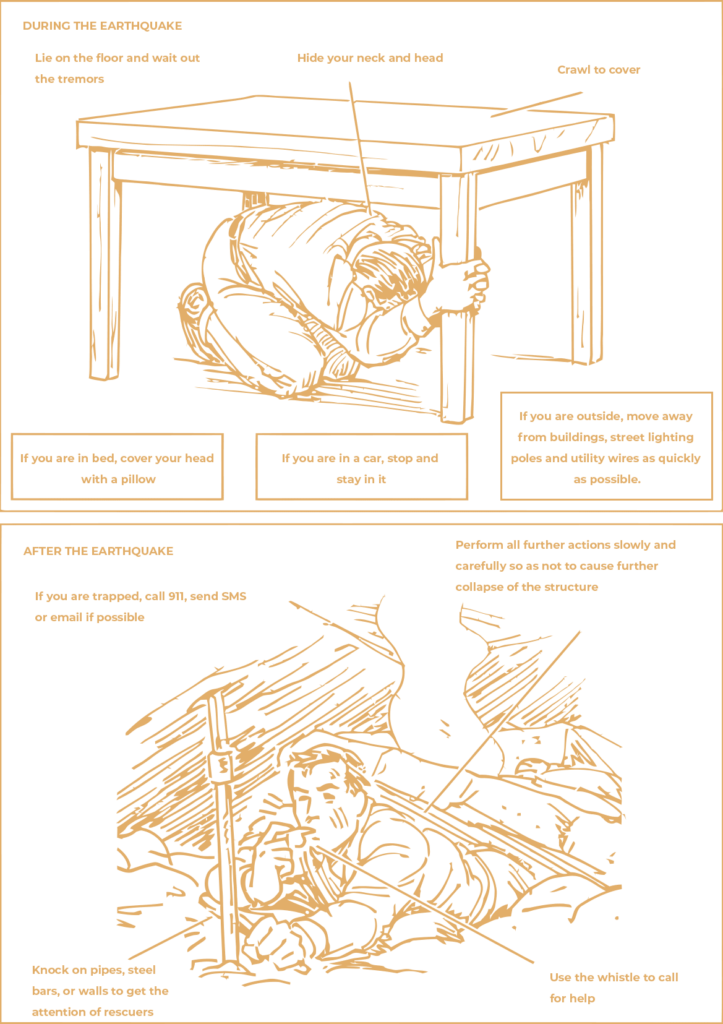EARTHQUAKE
About 20,000 earthquakes occur on the globe every year, of which only 15 are major seismic events. But in most cases, people are rather frivolous about a possible disaster of this kind and, accordingly, they are preparing for it in the same way. This also applies to residents of areas prone to frequent seismic activity. In addition, many of the official earthquake safety regulations are outdated. One such outdated recommendation – to get into the nearest doorway as soon as possible – came from the 19th century, when wooden doorways were the safest places in California houses built of clay. Nowadays, the design of private houses has changed a lot, moreover, the doorway will not protect you from flying objects.
Really safe areas in the home include sturdy pieces of furniture such as dining and work tables, as well as the corners of rooms and spaces near interior walls. Stay away from windows and glass surfaces.
Causes of earthquakes
- Tectonic. Most of the earthquakes recorded in the world have arisen as a result of tectonic plate movements, when there is a sharp displacement of rocks. Although this shift is usually small, only a few centimeters, the mountains located above the epicenter are in motion and emit tremendous energy. As a result, cracks form on the earth’s surface, along the edges of which huge tracts of land begin to move along with everything that is on it – fields, houses, people.
- Volcanic. Such fluctuations, although weak, continue for a long time. Usually they do not pose a particular danger, but the catastrophic consequences were still recorded.
- Landslide. The shocks are usually mild, but in some cases, the effects can be catastrophic.
- Technogenic. In some cases, the causes and consequences of earthquakes are often associated with human activities. Scientists have recorded an increase in the number of tremors in the areas of large reservoirs. This is due to the fact that the collected mass of water begins to put pressure on the earth’s crust below, and water penetrating through the ground destroys it. In addition, an increase in seismic activity was observed in oil and gas production sites, as well as in the area of mines and open pits.
- Artificial. The strength of such shocks directly depends on the cause of their occurrence, and the consequences can be very different. For example, after testing a new nuclear weapon of the DPRK in many places on the planet, sensors recorded earthquakes of moderate strength.
- Seaquake. An underwater earthquake occurs when tectonic plates collide on the ocean floor or near the coast. If the source is located shallow, and the magnitude is 7, an underwater earthquake is extremely dangerous because it causes a tsunami. During the shuddering of the sea crust, one part of the bottom sinks, the other rises, as a result of which the water, in an attempt to return to its original position, begins to move vertically, generating a series of huge waves going towards the coast. Such an earthquake, together with a tsunami, often leads to catastrophic consequences.
The focus of an earthquake is a rupture, after the formation of which the earth’s surface is instantly displaced. The plates bump into each other, resulting in friction and energy, which is gradually accumulated.
When the stress becomes maximum and begins to exceed the frictional force, the rocks break, after which the released energy is converted into seismic waves moving at a speed of 8 km / s and causing the earth to vibrate.
Epicenter depth classification
- Normal – epicenter up to 70 km;
- Intermediate – epicenter up to 300 km;
- Deep focus – epicenter at depths exceeding 300 km, typical of the Pacific Rim. The deeper the epicenter, the further the seismic waves generated by the energy will travel.
An earthquake has several stages. The main, most powerful sense is preceded by warning fluctuations – foreshocks, followed by aftershocks, subsequent tremors, and the magnitude of the strongest aftershock is 1.2 less than that of the main shock.
The period from the beginning of foreshocks to the end of aftershocks may well last for several years.
The main impetus usually lasts less than a minute. It is extremely difficult to calculate which kick will be the main one and will have the greatest magnitude. It often happens that the strongest shudders occurring on one side of the planet shake the opposite side. One of the ways to measure the amplitude of oscillations and the amount of released energy is the scale of magnitudes (Richter scale), which contains conventional units from 1 to 9.5. It is often confused with a twelve-point intensity scale, measured in points.
Richter scale
- 2 – weak almost imperceptible vibrations;
- 4 – 5 – although the tremors are weak, they can lead to minor damage;
- 6 – medium damage;
- 8.5 – one of the strongest recorded earthquakes.
- The largest is considered the Great Chilean earthquake with a magnitude of 9.5, which gave rise to a tsunami, which, having overcome 17 thousand kilometers of the Pacific Ocean, reached Japan.
An increase in the magnitude of earthquakes by only one unit means an increase in the amplitude of oscillations by ten times, and in energy by thirty-two times.
To understand why earthquakes occur, scientists have developed a scale of intensity based on such external manifestations as the impact on people, animals, buildings, nature. The closer the epicenter of earthquakes to the earth’s surface, the greater the intensity. According to the scale, the first damage can occur as early as six-point kicks, forming cracks appear in the plaster. An earthquake of eleven points is considered catastrophic – the surface of the earth’s crust is covered with cracks, buildings are destroyed. The strongest earthquakes that can significantly change the appearance of the area are estimated at twelve points.
Preliminary preparation
Make your home more earthquake resistant.

To do this, place heavy pieces of furniture on the ground floor. Attach the stretch wire to the ceiling joist to securely hold hanging lights and fans. Use anti-seismic hooks and strong adhesives to attach framed paintings and photographs to walls. Attach large wall mirrors and TVs securely with hidden hooks. Residents of geologically active zones are advised to collect an earthquake kit. It includes tools, a container of water at the rate of 4-5 liters per person per day and a supply of food for a week. In addition, it will be useful to prepare an “emergency suitcase” with basic necessities. If possible, keep several these “suitcases”. Store the first in the car, the second in the bedroom, and the third in the kitchen or living room.
It is not known in advance what the consequences of an earthquake could be – from the destruction of building foundations to floods, fires and even riots, so it is better to prepare for a possible evacuation.
Action plan
During an earthquake, follow the most important recommendation from the safety protocol: stop, lower yourself to the floor, or climb under the shelter and wait out the tremors.
Lie down yourself – don’t wait when an earthquake will throw you to the ground. If possible, find cover and hold onto something so that you do not roll away from the tremors somewhere to the side. Don’t go outside. Falling trees and power lines can be a serious hazard. If you are in bed, stay in it, but cover your face with a pillow to protect yourself from flying objects and shards of glass.

If during an earthquake you were driving a car, pass overpasses and tall trees, stop immediately and stay in the car. Once trapped under large wreckage or falling into a basement or underground sinkhole, take all further actions slowly and carefully so as not to cause further collapse of the structure. If your “emergency suitcase” is nearby, use the whistle to call for help. You can also knock on pipes or reinforcing steel. Sounds will be loud enough that emergency responders may be able to hear you. In coastal areas, an earthquake may be followed by a tsunami, so as soon as the tremors stop, move to a elevation as soon as possible.






